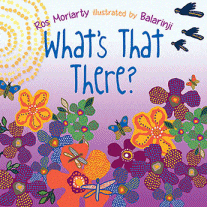
What’s That There?
What’s That There?
Ros Moriarty
Balarinji
Allen & Unwin, 2017
24pp., pbk., RRP $A12.99
9781760297817
Australia is more than a landscape of endless red plains and grey-green gum trees, and in this vividly illustrated book younger readers are encouraged to look more closely at the landscape around them.
Using a predictable text pattern of both question and answer and repetition, the reader is invited to examine the bird’s-eye view of the landscape and engage with the illustrations to identify what it is the bird sees.
What’s that there?
“That’s the rushing river’s curly bend,” cries the sea eagle perched on a swaying, knotted branch. “There, look!”
And in stunning pictures, based on traditional Aboriginal designs and created by Balarinji established by the author and her husband, the astute young reader can indeed pick out the river winding through and the sea eagle from its on-high perch. Or the hawk soaring over the “cliff face sharp with sun-scorched stones glinting”. Or “the dry, cracked billabong sleeping” that the stick-bug clinging to the peeling tree bark sees.
As well as being a celebration of the country and its creatures, the poetic text and the stunning illustrations introduce landscapes that may be familiar but but are unseen as we race through life, not pausing to see things through artistic or linguistic eyes, Not only does it encourage us to slow down and think about what we are seeing, it also offers a different perspective. What do the tops of the grey-green bush look like to the magpies, currawongs and crimson rosellas that are always flying over and around my house? What do they make of the dun coloured, drought-affected grasses that stretch between the trees?
Understanding and using the bird’s-eye view perspective where things are seen from above, often an unfamiliar angle for our little ones, is a difficult concept to grasp and yet it is an essential skill of mapping and “unplugged coding” so this book is an intriguing way of introducing them to that concept, perhaps even challenging them to try their hand at interpreting their own surroundings from such a perspective.
For those who want to explore a different aspect, there is a translation of the English into the Yanyuwa language (spoken in families in Borroloola , NT) at the end which not only allows the young readers of those families to see and read stories in their own language as part of the author’s Indi Kindi initiative but also demonstrates that not everyone speaks English as their first language offering the opportunity to explore the languages spoken by classmates and families and celebrate the value of that first language.
For a seemingly simple, 24 page book there is so much packed into this, it is a must-have in your collection.

More artwork created by Balarinji